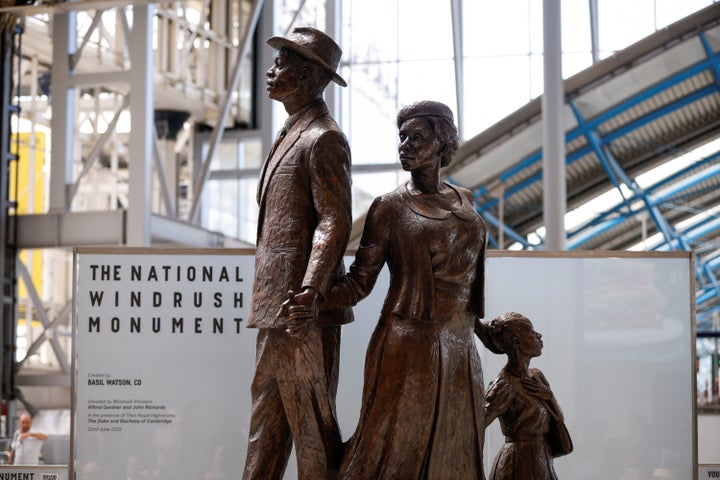
The new Windrush monument in London has been praised for its symbolism – and torn apart for just painting over the problems the Windrush generation still face today.
The statue, unveiled on Windrush Day in Waterloo train station, shows a man, woman and child in their Sunday best standing on top of suitcases.
It was designed by the Jamaican artist and sculptor Basil Watson and is meant to honour the 500,000 people who came to the UK between 1948 and 1971 from the Caribbean, when Britain had a serious labour shortage following World War 2.
The monument has been praised by some, including Labour MP David Lammy, for representing this generation.
However, others believe the monument – which cost £1 million – actually embodies the entire UK approach to the Windrush generation and the subsequent scandal.
The scandal which emerged in April 2018 revealed the Commonwealth citizens’ children had been threatened with deportation by the government over a lack of paperwork.
Downing Street did apologise, but is yet to compensate every victim.
Campaign group Windrush Lives criticised the decision to build the statue, considering the average compensation for the victims of this scandal is around £94,000. That is less than 10% of the cost of the monument.
The group also called for the government to prioritise other elements of the scandal, tweeting: “Make the WCS [Windrush Compensation scheme] independent, and announce a statutory inquiry into the causes of the Windrush Scandal, the ongoing trauma that it has given rise to, and the Hostile Environment.
“Until that’s done, stuff your statues and memorials.”
The Hostile Environment policy refers to legislative measures meant to make it harder for people to stay in the UK without leave to remain – pushing them to “voluntarily leave”.
Trustee for the charity Mind, Rohan Kallicharan, also explained on Twitter that while he was appreciative for the statue, it did not excuse all the underlying problems in the UK.
He wrote: “Still we live in a country that is so full of prejudice and division, where the correlation between skin colour, race and socio-economic division is so clear. And let us not forget that is is a country ready to turn its back on immigrants.”
Kallicharan is likely referring to the Home Office’s extremely controversial decision to fly supposedly “illegal” asylum seekers to Rwanda.
Other critics, including Labour MP Diane Abbott, also pointed out that while the government has been praising the Windrush generation, it is still “dragging its feet” over the scandal itself.
Esteemed writer, campaigner and lecturer Professor Gus John also wrote an open letter to the government rejecting the invitation to attend the unveiling of the monument.
“I am still puzzled as to why I was sent that invitation, as I am on public record as condemning the entire Windrush construct as a sham and as a gross distortion of the relationship between the African diaspora, from the Caribbean and the African continent and Britain,” he explained.
He accused the British statue of perpetuating “a culture of racism that has violated the human rights of Black Commonwealth and of British born and naturalised citizens,” and also took aim at the Hostile Environment policy.
He then pulled apart the Windrush Commemoration Committee’s decision to describe the artwork as a “permanent place of reflection and inspiration”.
“The Windrush narrative itself erases that shared history and heritage and refers lazily to the ‘Windrush generation’ as if they had no past and no experience with Britain before arriving in Britain.”
He said praise for this generation did not include the legacy of their “perennial struggle against systemic racism, neo-fascism and English nationalism”.
He also pointed out that the Immigration Act 1971 curtailed anyone seeking to come to the UK as people had to seek permanent residence to demonstrate partial links to Britain or be legal residents for five years or more.